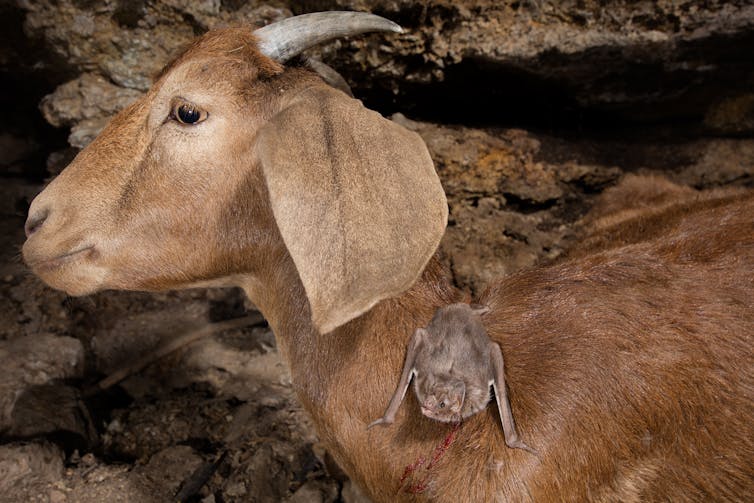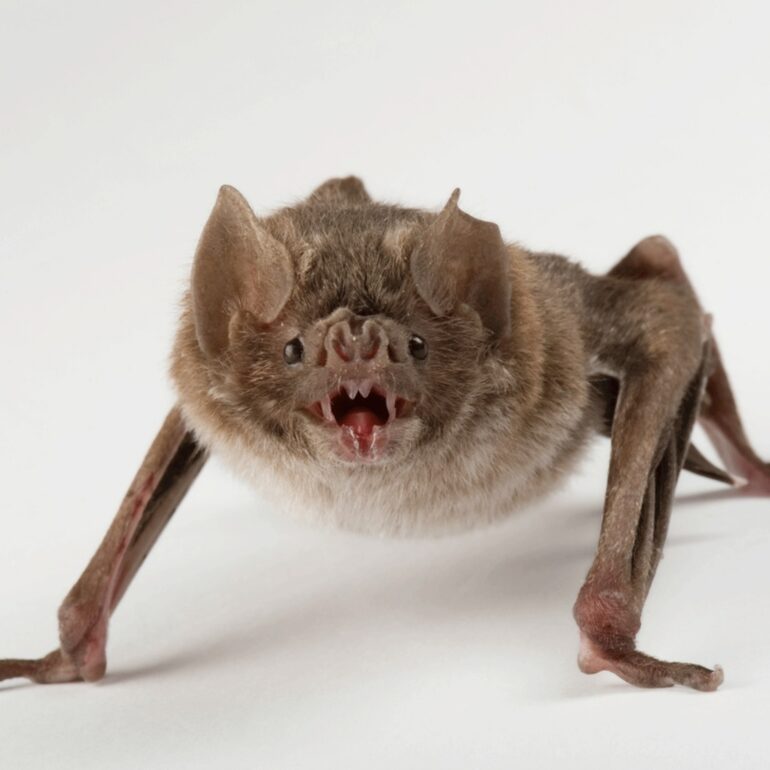You can probably picture a vampire: Pale, sharply fanged undead sucker of blood, deterred only by sunlight, religious paraphernalia and garlic. They’re gnarly creatures, often favorite subjects for movies or books. Luckily, they’re only imaginary … or are they?
There are real vampires in the world of bats. Out of over 1,400 currently described bat species, three are known to feed on blood exclusively.
The common vampire bat, Desmodus rotundus, is the most abundant. At home in the tropical forests of Central and South America, these bats feed on various animals, including tapirs, mountain lions, penguins and, most often nowadays, livestock.

A vampire bat enjoys a blood meal at the expense of a domestic goat.
Nicolas Reusens/Moment via Getty Images
Feeding on a blood diet is unusual for a mammal and has led to many unique adaptations that facilitate their uncommon lifestyle. Unlike other bats, vampires are mobile on the ground, toggling between two distinct gaits to circle their sleeping prey. Heat-sensing receptors on their noses help them find warm blood under their prey’s skin. Finally, the combination of a small incision, made by potentially self-sharpening fangs, and an anticoagulant in their saliva allows these bats to feed on unsuspecting prey.
To me, as a behavioral ecologist, who is interested in how pathogens affect social behaviors and vice versa, the most fascinating adaptations to a blood-feeding lifestyle are observable in vampire bats’ social lives.
Vampire bats build reciprocal relationships
Blood is not very nutritious, and vampire bats that fail to feed will starve relatively quickly. If a bat returns to the roost hungry, others may regurgitate a blood meal to get them through the night.

Vampire bats will share their blood meal with a hungry friend.
Gerry Carter
Such food sharing happens between bats who are related – such as mothers and their offspring – but also unrelated individuals. This observation has puzzled evolutionary biologists for quite a while. Why help someone who is not closely related to you?
It turns out that vampire bats keep track of who feeds them and reciprocate – or not, if the other bat has not been helpful in the past. In doing so, they form complex social relationships maintained by low-cost social investments, such as cleaning and maintaining the fur of another animal, called allogrooming, and higher-cost social investments, such as sharing food.
These relationships are on par with what you would see in primates, and some people compare them to human friendships. Indeed, there are some parallels.
For instance, humans will raise the stakes when forming new relationships with others. You start with social investments that don’t cost much – think sharing some of your lunch – and wait for the other person’s response. If they don’t reciprocate, the relationship may be doomed. But if the…



